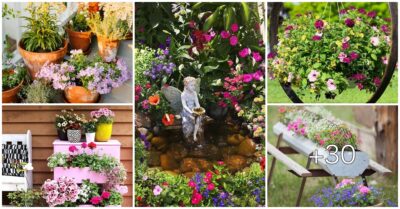While most gardeners think of planting new flowers in spring and autumn, summer is a great time to expand your flower beds too. And even if the temperatures are soaring, there are still plenty of plants that are great for planting at this time of the year.
So read on to discover some great plants to sow during summer’s peak, from June to August. We love these plants and we are sure you will too if you decide to add these showstopping blooms to your garden this growing season.
Sunflowers
Nothing says “summer” quite like sunflowers and no garden would be complete without them. These showstoppers come in all sizes, from petite dwarfs to gigantic mammoth sunflowers that tower 10’ tall or higher!
While mostly known for their golden-yellow petals, sunflowers come in different colors too, such as warm burgundy, orange, cream and bright white.
A favorite among large pollinators, like birds, hummingbirds and butterflies, sunflowers are some of the best plants to attract beneficial insects to your garden too. And, if you love sunflower seeds as a snack, you can certainly grow these edible plants for that too. For something a bit different, entire sunflower heads can even be grilled and drizzled with a homemade vinaigrette or other sauce!
Sunflower seeds are best planted via direct sowing in late spring; however, in cooler areas, you can still plant sunflowers in early summer too. If you don’t want to grow your plants from seed, you can usually find some starts at local nurseries and box stores too.



| Plant Name: | Sunflowers |
| Uses: | Ornamental, Pollinator Favorite, Edible |
| How to Grow: | Seeds |
| Lighting: | Full sun |
| Water: | Moderate |
| Minimum Grow Zone: | Annual |
Iris
It’s no wonder why irises are some of the most popular garden flowers to grow in summer. These showy plants are simple to keep and add lots of color and structure to planting arrangements.
There are somewhere between 250 to 300 species of irises today. Those varieties range in size from dwarf plants to tall, bearded irises. While purple irises are often most common, they come in blue, white, red, pink and other assorted colors too. Some irises, such as true water irises, are semi-aquatic species and make wonderful additions to water gardens.
Whether you want to plant new flowers or divide existing clumps of irises, it’s best to handle these plants in summer, from late July to the middle of August. Growing in mounds, irises should be divided in summer every 3 to 5 years for best growth.



| Plant Name: | Iris |
| Uses: | Ornamental |
| How to Grow: | Nursery starts, Bulbs |
| Lighting: | Full sun |
| Water: | Moderate; some aquatic species available |
| Minimum Grow Zone: | Depends on variety |
Hibiscus
Tropical hibiscus may look exotic, but you can grow them in any garden, even in cold areas! Of course, in cold areas hibiscus only grows as annual, but in zones 10 and above you can keep this thrilling specimen as a perennial too.
When grown as a perennials, hibiscus can grow quite large, often over 5’ tall; however, they’ll stay much smaller in colder locations. Preferring full sun, hibiscus flowers come in red, pink, lavender and white. Hibiscus are also super attractive to pollinators, particularly hummingbirds and butterflies.
Hibiscus can be planted in spring through fall, but they are usually planted in summer in cold locations. Temperatures below 55° F can damage these beauties, so make sure you soil is nice and warm before planting.
While there are many different hibiscus varieties to try, for a special treat, grow Hibiscus sabdariffa. This plant is not only beautiful, but its flowers and leaves are also edible and taste great in jams, teas and lemonade.




| Plant Name: | Hibiscus |
| Uses: | Ornamental, Pollinator Favorite, Edible (Hibiscus sabdariffa) |
| How to Grow: | Nursery starts |
| Lighting: | Full sun |
| Water: | Moderate |
| Minimum Grow Zone: | Zone 10 |
Marigolds
No garden is complete without marigolds and that especially holds true for vegetable gardens. While marigolds are lovely statement flowers, they really shine when put to work in your garden for natural pest control.
Marigolds’ fragrance is off-putting to many garden pests and so these flowers are often interplanted in gardens to keep mosquitoes, cabbage loopers, rabbits and other destructive garden pests away. In terms of natural pest control, French marigolds are often the best choice to plant.
If you want to grow marigolds just for their blooms, that’s great too. These cheery flowers come in yellow, orange and red. Plants can grow up to 3’ tall, although they come in dwarf varieties too.
To grow your own marigolds from seed, start seeds indoors about 8 weeks before your last frost date. For earlier blooms, however, opt for nursery starts, which can be purchased from spring to fall and are usually quite easy to find.


| Plant Name: | Marigolds |
| Uses: | Ornamental, Pollinator Favorite, Natural Pest Control |
| How to Grow: | Nursery starts, Seeds |
| Lighting: | Full sun |
| Water: | Moderate |
| Minimum Grow Zone: | Annual |
Canna Lilies
Tropical-looking canna lilies are hard to miss with their bright flowers in yellow, orange and blood red. Native to North and South America, canna lilies are not fond of cold weather and should be planted in late spring to early summer, after all danger of frost has passed.
If you live in a particularly cold area, you can extend your growing season by starting your canna lilies indoors 4 weeks before your last frost date. Even better, as canna lilies grow from rhizomes, you can dig up and overwinter your plants indoors if live in a cold climate to keep your plants going strong for years.
Great for inground planting, container gardens and cut flower arrangements, canna lilies have long lasting flowers that appear in summer and last well into fall. For a particularly striking look, add some canna lilies to a pot near your front door for a nice pop of color.


| Plant Name: | Canna Lilies |
| Uses: | Ornamental, Cut Flowers |
| How to Grow: | Nursery starts, Bulbs |
| Lighting: | Full sun to part shade |
| Water: | Moderate |
| Minimum Grow Zone: | Zone 7 |
Scabiosa
Otherwise known as pincushion flowers, scabiosa are popular plants thanks to their showy globe-shaped flowers that exude a feminine and airy quality.
Best planted in full sun to part shade, scabiosa is a great choice for succession planting as it will ensure these gorgeous flowers keep blooming all season long. Plants can be started indoors 6 to 8 weeks before your last frost date and then transplanted outside. After that, simply direct sow seeds in your garden every two weeks through mid-summer for continuous blooms.
When started from seed, scabiosa can take up to 100 days to flower; however, you can speed this process along by purchasing nursery starts.
These long-lasting flowers grow as perennials to zone 3, so if you enjoy them, you’ll be happy to know your plants will come back year after year.


| Plant Name: | Scabiosa |
| Uses: | Ornamental, Cut Flowers, Dried Flowers |
| How to Grow: | Nursery starts, Seeds |
| Lighting: | Full sun |
| Water: | Moderate |
| Minimum Grow Zone: | Annual |
Celosia
If you like bold colors, plant some celosia. With oddly shaped flowers in purple, red, orange and gold, celosia blooms look like something from under the sea. Flower shapes come in either plumed, wheat or cockscomb, but cockscomb tends to be the most popular for many outdoor arrangements.
Preferring full sun, celosia loves heat and should not be planted outdoors until soil is well warmed. That makes summer an ideal time to plant these stunners.
Great for inground planting or container beds and window boxes, celosia works well in cut arrangements and dries nicely for preserved bouquets too.
Blooming from July to October, when sown from seed, celosia needs about 90 days to mature enough to flower. If you want to grow celosia from seed, start them inside about 4 to 6 weeks before your last frost date or sow them directly in your garden after the danger of frost has passed.
These popular plants are also readily available at most plant nurseries, so if you’re in a rush, purchase some nursery starts instead.


| Plant Name: | Celosia |
| Uses: | Ornamental, Cut Flowers, Dried Flowers |
| How to Grow: | Nursery starts, Seeds |
| Lighting: | Full sun |
| Water: | Moderate to high |
| Minimum Grow Zone: | Zone 10 |
Zinnias
For color lovers, you can’t go wrong with zinnias. These vibrant flowers come in every color but blue, so you’re sure to find one to accentuate your garden design.
Similar in appearance to dahlias, zinnias often have globe-like flowers in either double or single blooms. Plant sizes can range from petite dwarf plants to 4’ tall varieties that are certain to be the focal point of any bed.
Grown as annuals, zinnias can either be started from seed or purchased as nursery starts. If you choose to grow yours from seed, sow your zinnias 4 to 6 weeks before your last frost date. After all threat of frost has passed, transfer your plants out in early summer for plants that will bloom all season until the frosts of fall.
Naturally deer resistant, zinnias are great flowers to attract beneficial insects and pollinators to your garden too!




| Plant Name: | Zinnias |
| Uses: | Ornamental, Pollinator Favorite |
| How to Grow: | Nursery starts, Seeds |
| Lighting: | Full sun |
| Water: | Moderate to high |
| Minimum Grow Zone: | Annual |
Petunias
Whether you’re looking for bright colored border plants or something to perk up your front porch planters or hanging baskets, petunias are one of the best flowers for the job. And if their colors weren’t enough of a reason to add petunias to your landscape, they’ve got a delightful fragrance too!
Perennial in zones 9 and above, petunias are most commonly grown as annuals, but that doesn’t detract from their charm. With trumpet-shaped flowers in white, yellow, purple, red, blue, pink and multicolored, petunias are one of the easiest ways to enliven beds with lots of big splashes of color.
Surprisingly, petunias are actually members of the nightshade family and are related to tomatoes and peppers. They can be useful in the garden too as they help to repulse common insects like tomato hornworms, squash bugs and aphids.
Super low maintenance, petunias just need regular watering, can adapt to full sun to part shade and will bloom all season long, from spring until autumn frosts arrive.



| Plant Name: | Petunias |
| Uses: | Ornamental |
| How to Grow: | Nursery starts, Seeds |
| Lighting: | Full sun |
| Water: | High |
| Minimum Grow Zone: | Zone 9 |
Ranunculus
Ranunculus are most frequently planted in spring or fall; however, they are great choices for summer planting in cool areas. Their bright colors look delightful in container beds — just be sure to give your plants lots of water and a bit of protection from afternoon sun to help your new plants acclimate.
Native to the Mediterranean, ranunculus are actually related to wild buttercups, but their flowers come in more than just yellow! Ranunculus blooms can be found in white, pink, orange, red and purple too!
In colder areas, zone 6 and below, ranunculus are grown as annuals. However, they can be overwintered indoors by gently digging up their corms (a rhizome-like root system) and storing them in a cool, dry location until spring.



| Plant Name: | Ranunculus |
| Uses: | Ornamental, Cut Flowers |
| How to Grow: | Nursery starts, Bulbs |
| Lighting: | Full sun |
| Water: | Moderate |
| Minimum Grow Zone: | Zone 7 |
Geraniums
Geraniums may be some of the most popular flowers to grow in summer, but there’s a good reason for that. With big clusters of colorful flowers in red, pink and white, geraniums work well in hanging baskets, window boxes, container gardens, inground beds — you name it!
There are over 280 different types of geraniums, with garden geraniums being the type you’re most likely to spot at garden centers. However, another great summertime option is scented geranium, otherwise known as the citronella plant, which produces a citronella-like odor that can help repel common pests like mosquitos.
Geraniums are only hardy to zone 10. In colder regions, these beauties are grown as annuals. Because they are not cold hardy, geraniums are best planted in late spring to early summer, after all danger of frost has passed.


| Plant Name: | Geraniums |
| Uses: | Ornamental, Natural Pest Control (Citronella Geranium) |
| How to Grow: | Nursery starts |
| Lighting: | Full sun, except for ivy geranium |
| Water: | Moderate |
| Minimum Grow Zone: | Depends on variety |
Thank you for spending time to see this article of Ideassimple about 11 The Most Beautiful Flowers To Plant In The Summer. Please give us a like, comment or share if you find the article good and meaningful. Have a good day!











